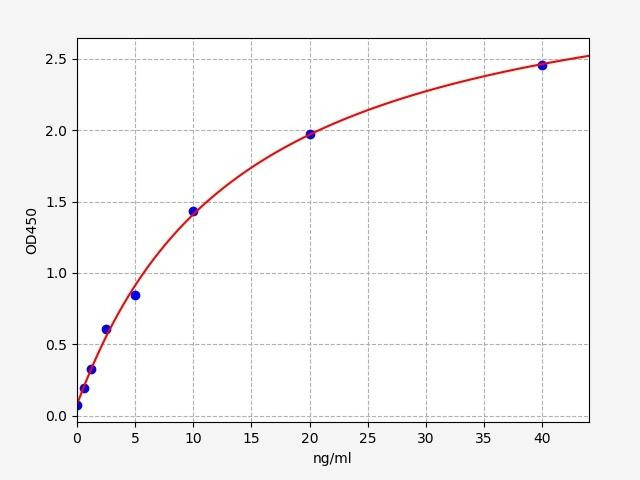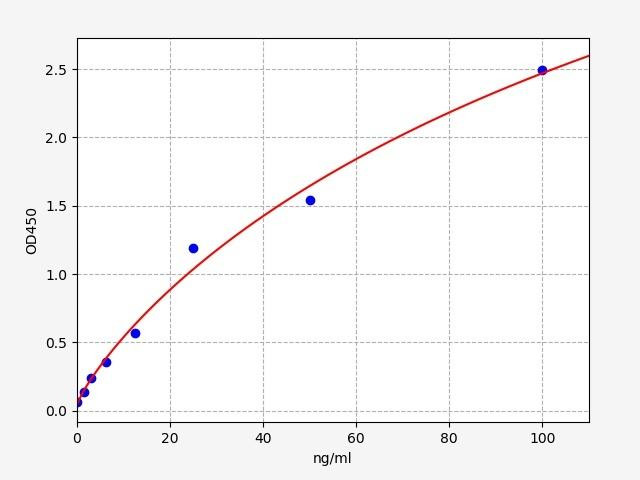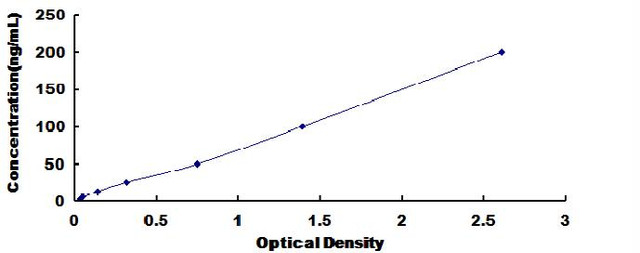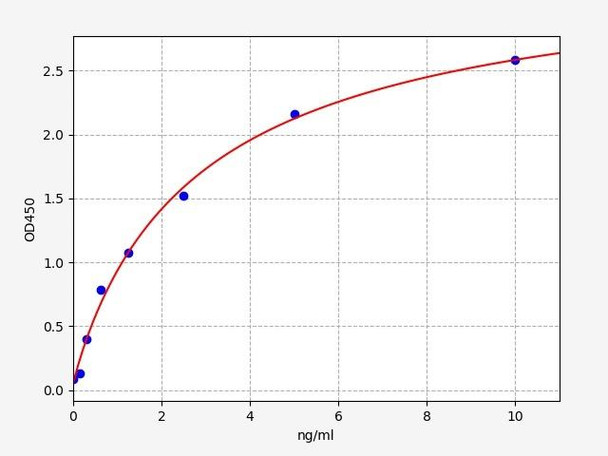Porcine E-Selectin / CD62E ELISA Kit (PRFI00148)
- SKU:
- PRFI00148
- Product Type:
- ELISA Kit
- Size:
- 96 Assays
- Uniprot:
- P98110
- Sensitivity:
- 0.094ng/ml
- Range:
- 0.156-10ng/ml
- ELISA Type:
- Sandwich
- Synonyms:
- E-Selectin, SELE, CD62E, CD62E, ELAM1, LECAM2, SELE, CD62 antigen-like family member E, CD62E, CD62E antigen, ELAM, ELAM-14
- Reactivity:
- Porcine
Description
Porcine E-Selectin / CD62E ELISA Kit
E-selectin, also known as endothelial selectin or CD62E, is a cell adhesion molecule that plays a crucial role in the immune response and inflammatory processes within the body.The porcine E-Selectin ELISA kit enables researchers to accurately measure E-selectin concentrations, and facilitates investigations into inflammation, cardiovascular health, and related research areas.
Key Features
| Save Time | Pre-coated 96 well plate | |
| Quick Start | Kit includes all necessary reagents | |
| Publication Ready | Reproducible and reliable results |
Overview
| Product Name: | Porcine SELE (E-Selectin) ELISA Kit |
| Product Code: | PRFI00148 |
| Size: | 96 Assays |
| Alias: | E-Selectin, SELE, CD62E, CD62E, ELAM1, LECAM2, SELE, CD62 antigen-like family member E, CD62E, CD62E antigen, ELAM, ELAM-14 |
| Detection Method: | Sandwich ELISA, Double Antibody |
| Reactivity: | Porcine |
| Sensitivity: | 0.094ng/ml |
| Range: | 0.156-10ng/ml |
| Storage: | 4°C for 6 months |
| Note: | For Research Use Only |
Additional Information
| Recovery | Matrices listed below were spiked with certain level of Porcine SELE and the recovery rates were calculated by comparing the measured value to the expected amount of Porcine SELE in samples. Please contact us for more information. |
| Linearity: | The linearity of the kit was assayed by testing samples spiked with appropriate concentration of Porcine SELE and their serial dilutions. The results were demonstrated by the percentage of calculated concentration to the expected. Please contact us for more information. |
| Intra Assay | CV < 8% |
| Inter Assay | CV < 10% |
Kit Components
| Component | Quantity | Storage |
| ELISA Microplate (Dismountable) | 8x12 strips | 4°C for 6 months |
| Lyophilized Standard | 2 | 4°C/ -20°C |
| Sample/Standard Dlution Buffer | 20ml | 4°C |
| Biotin-labeled Antibody (Concentrated) | 120ul | 4°C (Protection from light) |
| Antibody Dilution Buffer | 10ml | 4°C |
| HRP-Streptavidin Conjugate (SABC) | 120ul | 4°C (Protect from light) |
| SABC Dilution Buffer | 10ml | 4°C |
| TMB Substrate | 10ml | 4°C (Protection from light) |
| Stop Solution | 10ml | 4°C |
| Wash Buffer (25X) | 30ml | 4°C |
| Plate Sealer | 5 | - |
Other materials required:
- Microplate reader with 450 nm wavelength filter
- Multichannel Pipette, Pipette, microcentrifuge tubes and disposable pipette tips
- Incubator
- Deionized or distilled water
- Absorbent paper
- Buffer resevoir
Protocol
*Note: Protocols are specific to each batch/lot. For the exact instructions please follow the protocol included in your kit.
Before adding to wells, equilibrate the SABC working solution and TMB substrate for at least 30 min at 37°C. When diluting samples and reagents, they must be mixed completely and evenly. It is recommended to plot a standard curve for each test.
| Step | Procedure |
| 1. | Set standard, test sample and control (zero) wells on the pre-coated plate respectively, and then, record their positions. It is recommended to measure each standard and sample in duplicate. Wash plate 2 times before adding standard, sample and control (zero) wells! |
| 2. | Aliquot 0.1ml standard solutions into the standard wells. |
| 3. | Add 0.1 ml of Sample / Standard dilution buffer into the control (zero) well. |
| 4. | Add 0.1 ml of properly diluted sample ( Human serum, plasma, tissue homogenates and other biological fluids.) into test sample wells. |
| 5. | Seal the plate with a cover and incubate at 37 °C for 90 min. |
| 6. | Remove the cover and discard the plate content, clap the plate on the absorbent filter papers or other absorbent material. Do NOT let the wells completely dry at any time. Wash plate X2. |
| 7. | Add 0.1 ml of Biotin- detection antibody working solution into the above wells (standard, test sample & zero wells). Add the solution at the bottom of each well without touching the side wall. |
| 8. | Seal the plate with a cover and incubate at 37°C for 60 min. |
| 9. | Remove the cover, and wash plate 3 times with Wash buffer. Let wash buffer rest in wells for 1 min between each wash. |
| 10. | Add 0.1 ml of SABC working solution into each well, cover the plate and incubate at 37°C for 30 min. |
| 11. | Remove the cover and wash plate 5 times with Wash buffer, and each time let the wash buffer stay in the wells for 1-2 min. |
| 12. | Add 90 µl of TMB substrate into each well, cover the plate and incubate at 37°C in dark within 10-20 min. (Note: This incubation time is for reference use only, the optimal time should be determined by end user.) And the shades of blue can be seen in the first 3-4 wells (with most concentrated standard solutions), the other wells show no obvious color. |
| 13. | Add 50 µl of Stop solution into each well and mix thoroughly. The color changes into yellow immediately. |
| 14. | Read the O.D. absorbance at 450 nm in a microplate reader immediately after adding the stop solution. |
Sample Preparation
When carrying out an ELISA assay it is important to prepare your samples in order to achieve the best possible results. Below we have a list of procedures for the preparation of samples for different sample types.
| Sample Type | Protocol |
| Serum | If using serum separator tubes, allow samples to clot for 30 minutes at room temperature. Centrifuge for 10 minutes at 1,000x g. Collect the serum fraction and assay promptly or aliquot and store the samples at -80°C. Avoid multiple freeze-thaw cycles. If serum separator tubes are not being used, allow samples to clot overnight at 2-8°C. Centrifuge for 10 minutes at 1,000x g. Remove serum and assay promptly or aliquot and store the samples at -80°C. Avoid multiple freeze-thaw cycles. |
| Plasma | Collect plasma using EDTA or heparin as an anticoagulant. Centrifuge samples at 4°C for 15 mins at 1000 × g within 30 mins of collection. Collect the plasma fraction and assay promptly or aliquot and store the samples at -80°C. Avoid multiple freeze-thaw cycles. Note: Over haemolysed samples are not suitable for use with this kit. |
| Urine & Cerebrospinal Fluid | Collect the urine (mid-stream) in a sterile container, centrifuge for 20 mins at 2000-3000 rpm. Remove supernatant and assay immediately. If any precipitation is detected, repeat the centrifugation step. A similar protocol can be used for cerebrospinal fluid. |
| Cell culture supernatant | Collect the cell culture media by pipette, followed by centrifugation at 4°C for 20 mins at 1500 rpm. Collect the clear supernatant and assay immediately. |
| Cell lysates | Solubilize cells in lysis buffer and allow to sit on ice for 30 minutes. Centrifuge tubes at 14,000 x g for 5 minutes to remove insoluble material. Aliquot the supernatant into a new tube and discard the remaining whole cell extract. Quantify total protein concentration using a total protein assay. Assay immediately or aliquot and store at ≤ -20 °C. |
| Tissue homogenates | The preparation of tissue homogenates will vary depending upon tissue type. Rinse tissue with 1X PBS to remove excess blood & homogenize in 20ml of 1X PBS (including protease inhibitors) and store overnight at ≤ -20°C. Two freeze-thaw cycles are required to break the cell membranes. To further disrupt the cell membranes you can sonicate the samples. Centrifuge homogenates for 5 mins at 5000xg. Remove the supernatant and assay immediately or aliquot and store at -20°C or -80°C. |
| Tissue lysates | Rinse tissue with PBS, cut into 1-2 mm pieces, and homogenize with a tissue homogenizer in PBS. Add an equal volume of RIPA buffer containing protease inhibitors and lyse tissues at room temperature for 30 minutes with gentle agitation. Centrifuge to remove debris. Quantify total protein concentration using a total protein assay. Assay immediately or aliquot and store at ≤ -20 °C |
| Breast Milk | Collect milk samples and centrifuge at 10,000 x g for 60 min at 4°C. Aliquot the supernatant and assay. For long term use, store samples at -80°C. Minimize freeze/thaw cycles. |
E-Selectin Background
E-Selectin
E-selectin, also known as endothelial selectin or CD62E, is a cell adhesion molecule that plays a crucial role in the immune response and inflammatory processes within the body. It is a type of selectin, which is a family of cell adhesion molecules involved in mediating interactions between different cell types, particularly white blood cells and the endothelial cells lining blood vessels.
E-selectin Gene (SELE):
The E-selectin gene, formally known as SELE (Selectin E), encodes the E-selectin protein. This gene is located on chromosome 4 in pigs. Variations in the SELE gene can impact the expression and function of E-selectin, which might influence an individual's susceptibility to certain inflammatory and cardiovascular conditions.
E-selectin Expression:
E-selectin is primarily expressed on the surface of endothelial cells, which line the inner surface of blood vessels. Its expression is induced by pro-inflammatory cytokines, such as interleukin-1 (IL-1) and tumor necrosis factor-alpha (TNF-α), in response to an inflammatory stimulus. When activated, endothelial cells display E-selectin on their surfaces to capture circulating leukocytes (white blood cells) and facilitate their migration from the bloodstream to the site of inflammation.
E-selectin Function:
The main function of E-selectin is to mediate the initial tethering and rolling of leukocytes along the blood vessel walls during the inflammatory response. This process is a crucial step in the recruitment of immune cells to sites of infection or tissue injury. E-selectin interacts with specific carbohydrate ligands on leukocytes, facilitating their adhesion to the endothelial cells. This rolling interaction allows leukocytes to scan the endothelial surface for chemotactic signals that guide them to the inflamed tissue.
E-selectin Clinical Significance:
The role of E-selectin in inflammation and immune responses makes it relevant in various clinical contexts. Some key clinical significances include:
- Inflammatory Diseases: E-selectin has been implicated in various inflammatory diseases, such as atherosclerosis, rheumatoid arthritis, and inflammatory bowel disease. The interaction between leukocytes and endothelial cells mediated by E-selectin contributes to the recruitment of immune cells to inflamed tissues.
- Cardiovascular Health: E-selectin is involved in the adhesion of leukocytes to endothelial cells in blood vessels, which is an early step in the development of atherosclerotic plaques. Elevated levels of E-selectin have been associated with an increased risk of cardiovascular events.
- Cancer Metastasis: In some cancers, E-selectin expression can facilitate the adhesion of circulating tumor cells to the endothelium of distant tissues, promoting the spread of cancer cells (metastasis).
- Therapeutic Target: Due to its role in inflammation and various diseases, E-selectin is being explored as a potential therapeutic target. Inhibiting E-selectin interactions could potentially help manage inflammatory disorders.
Porcine E-Selectin ELISA Kit FAQs
Q: What is the purpose of the Porcine E-Selectin ELISA kit?
The porcine E-Selectin ELISA kit is specifically designed for the quantitative determination of porcine E-selectin levels in various biological samples. E-selectin, a critical adhesion molecule, is involved in immune responses and inflammatory processes. This kit enables researchers to accurately measure E-selectin concentrations, and facilitates investigations into inflammation, cardiovascular health, and related research areas.
Q: What sample types can I use with this kit?
This kit is optimized for use with porcine serum, plasma, cell culture supernatants, and tissue homogenates. Detailed sample preparation instructions are provided in the kit's manual.
Q: Can this kit be employed for diagnostic purposes?
The porcine E-Selectin ELISA kit is intended for research applications and should not be used for diagnostic purposes. It's important to remember that research results should not be used for clinical decision-making.
Q: Is the kit compatible with other species?
This ELISA kit has been developed specifically for porcine samples. While it may cross-react withprotein from other species, it is recommended to consult the product manual or contact technical support for information regarding cross-reactivity.
Q: Where can I find additional technical support or assistance with the kit?
For any technical inquiries or assistance regarding the kit, you can reach out to our team. They will be available to answer your questions and provide the necessary guidance to ensure a successful experiment.
Related Products

| Porcine CD62P / P-selectin ELISA Kit | |
|---|---|
| ELISA Type: | Sandwich |
| Sensitivity: | 0.375ng/ml |
| Range: | 0.625-40ng/ml |

| Porcine VCAM1(Vascular cell adhesion protein 1) ELISA Kit | |
|---|---|
| ELISA Type: | Sandwich |
| Sensitivity: | 0.938ng/ml |
| Range: | 1.563-100ng/ml |

| Porcine Intercellular Adhesion Molecule 1 (ICAM1) ELISA Kit | |
|---|---|
| ELISA Type: | Sandwich |
| Sensitivity: | 1.42ng/mL |
| Range: | 3.125-200ng/mL |






